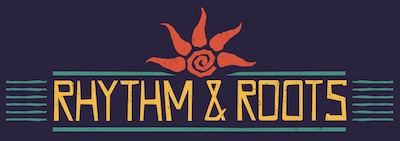Of all the colorful music fans at Rhythm & Roots, dressed in everything from tie dye and cowboy boots to swingy dresses and heels, Jeannine Chartier will stand out.
She’ll be the one covered in splotches of glue and glitter and maybe a stray feather, bead or bit of crepe paper here and there. Chartier, who uses crutches due to childhood polio, helped found VSA Arts more than 30 years ago to provide access to the arts for Rhode Islanders with disabilities, and her organization is sponsoring the Family Stage this year “for families, children and adults who still like to play,” she says.
Chartier and other artists and teachers from VSA Arts will help children with a wide range of abilities use everyday materials, glitter and glue included, to create art. Kids can make tiaras, necklaces, hats, small sculptures, masks from paper plates, and instruments from paper towel tubes and dry beans. The Scruffy Aristocrats will lead the sparkly children on a daily Mardis Gras-style parade around the grounds.
Producer Chuck Wentworth works hard to make sure everyone can have an equally great time, no matter their disability, Chartier says. “I’m not the only person who’s down there using crutches, or a wheelchair on occasion, and it’s not any different than how anyone else can be engaged or participate.” If needed, those with mobility impairments can call for a golf cart to transport them to their next stop at the festival.
Wentworth says the partnership with VSA Arts, along with the Tomaquag Museum in nearby Exeter, are natural fits for the festival, held Labor Day weekend every year at Ninigret Park. The park is named for Chief Ninigret, the great sachem of the Niantic and Narragansett people during the tumultuous occupation by European colonists in the mid-1600s.
The relationship between the modern-day Narragansetts and the town of Charlestown has been contentious at times, Wentworth says, “so bringing the tribe in to be part of the festival gives them some more visibility. Knowing more about the tribe might lead to some better understanding.”
Tomaquag, Rhode Island’s only indigenous museum, will present the music, stories and art of southern New England’s native peoples – past and present – to the Family Stage. It tends to be a busy place, exposing children, teens and their families to art-making, sing-alongs, comedians, games and nightly movies.
Chartier, who has Cajun roots herself, says Rhythm & Roots creates and strengthens cultural connections.
“In a troubled world, it’s such a relief to be able to hang out with all kinds of people who all have things in common. Everybody there is really into sharing their joy with each other.”
Both organizations enjoy the heightened visibility the festival brings, and the donations they receive go directly back to their organizations. VSA Arts also puts out tip jars at the beer and wine tents, and the money is used to keep programs running all year long. Outside of the festival itself, Rhythm & Roots sponsors youth sports teams every year.
To introduce children to roots music and everything else Rhythm & Roots offers, children age 12 and under get free admission, and teens (13-19) are half price. The Youth Camp is a no-charge benefit for children aged 8-18 in the community, even if their parents do not hold tickets to the festival. Children learn to play two Cajun tunes by ear on mandolin, fiddle, accordion, guitar or upright bass. The experience ends with a concert in the Dance Tent Sunday at 12:30.
The diversity and graciousness of the volunteers, vendors and roots music fans, and the inclusion of different cultures and physical abilities are big parts of the vibe that keeps people coming back year after year, Chartier says. “They all get to mix in together and create something that is bigger and stronger than any one of us could do separately. Everyone together makes this a fabulous festival.”
##
